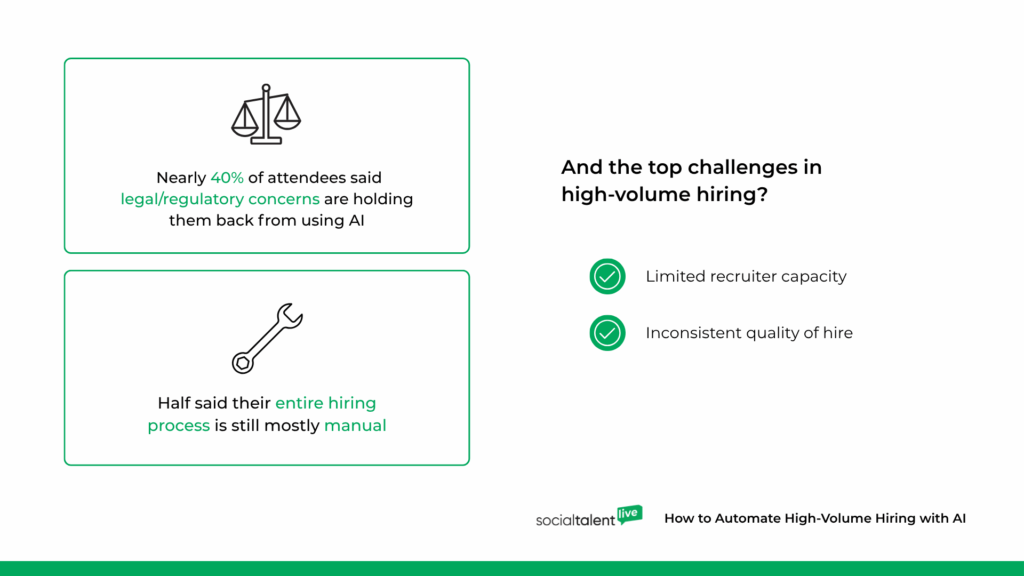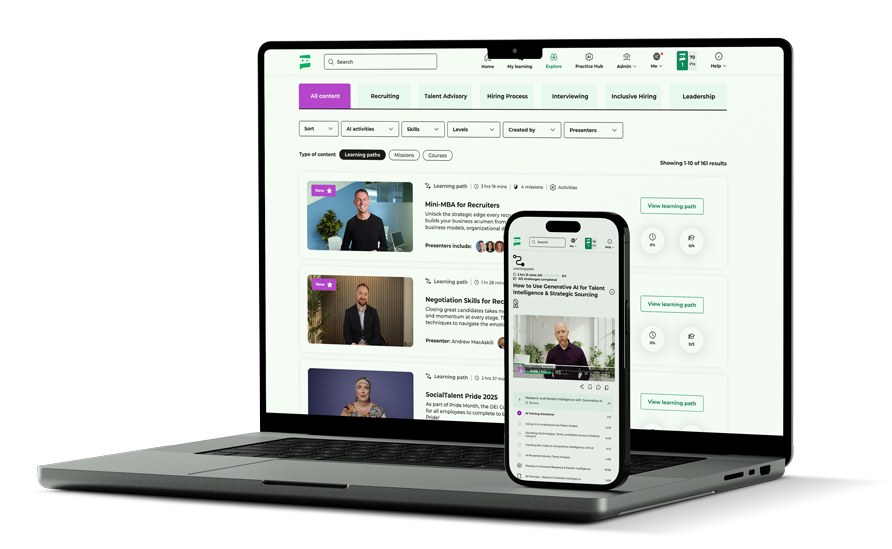
By David Deady
High-volume hiring has always been a balancing act. Recruiters juggle speed with quality, capacity with candidate experience, and cost with compliance – all while navigating an increasingly complex talent market.
Enter AI automation. The promise? End-to-end efficiency, reduced manual work, and faster time-to-hire without sacrificing the human touch. The reality? Many organizations are still hesitating to take the plunge.
At SocialTalent Live: How to Automate High-Volume Hiring with AI, we explored this tension with TA leaders from 7-Eleven, BT, and Sapia.ai. Alongside the conversations, we ran live polls to understand where our audience stood on automation adoption and the results told a revealing story:
- Nearly 40% said legal and regulatory concerns are holding them back from using AI.
- Half said their hiring process is still mostly manual.
- The top challenges? Limited recruiter capacity and inconsistent quality of hire.
Let’s unpack what these numbers mean, why they matter, and how leaders can chart a smarter path forward.

1. The Legal and Regulatory Brake
Poll insight: Nearly 40% of attendees said legal/regulatory concerns are holding them back from using AI.
On paper, AI automation is an easy sell. It speeds things up, reduces repetitive work, and creates a more seamless candidate journey. But in the real world, legal and compliance teams are raising the red flag – and for good reason.
From the EU AI Act to New York City’s bias audit laws, the rules of AI in hiring are evolving fast. Employers are rightly wary of introducing technology that could expose them to discrimination claims or regulatory penalties. In a high-volume environment where thousands of applicants pass through your systems, the stakes are high.
At the event, our speakers made one thing clear: compliance concerns aren’t an excuse to freeze innovation – they’re a call to design it better. Automation needs to be explainable, auditable, and defensible. That means involving compliance teams from the start, not bringing them in as the last step before launch.
The most forward-thinking TA leaders are reframing the conversation: rather than “Can we use AI?”, they’re asking, “How do we use it safely, ethically, and effectively?” When legal is treated as a partner in innovation, AI projects move faster and stand on firmer ground.
Learn more: How to Automate High-Volume Hiring with AI
2. Still Manual in a Machine-Ready World
Poll insight: Half said their entire hiring process is still mostly manual.
The buzz around AI in recruitment can make it seem like everyone is already automating, but the poll results tell a different story. Half of our audience is still operating with processes that are largely manual, relying on human intervention at almost every step.
Why the disconnect? Some leaders are cautious about investing before they’ve seen hard ROI. Others fear the disruption of overhauling entrenched workflows. In some cases, there’s simply a lack of awareness about the range of automation tools now available for high-volume hiring.
As our panelists pointed out, the first hurdle is mindset. Automation isn’t just swapping a manual step for a machine-led one. It’s rethinking the entire journey from application to offer:
- Can scheduling be handled by conversational AI instead of endless email chains?
- Can screening questions be automated and scored without recruiter oversight?
- Can onboarding be triggered automatically once an offer is accepted?
The companies leading in this space – like 7-Eleven and BT – didn’t just digitize their existing process. They redesigned it, often stripping it back to the essentials before layering in automation. The result? Faster time-to-hire, better candidate feedback, and more time for recruiters to focus on strategic work.
3. The Twin Challenges: Capacity and Quality
Poll insight: Top challenges in high-volume hiring are limited recruiter capacity and inconsistent quality of hire.
Capacity and quality may seem like separate problems, but they’re deeply intertwined. When recruiters are overloaded with admin – scheduling interviews, chasing documents, updating systems – they have less time to assess candidates meaningfully. Quality of hire inevitably suffers.
Our panelists shared stories that underline this point. Before their transformation, 7-Eleven recruiters were stretched thin managing thousands of applicants across two legacy systems. By removing 400 recruiter roles from the process and enabling store leaders with AI-driven tools, they freed up talent teams to focus on coaching, relationship-building, and quality checks rather than pure throughput.
This is where automation becomes more than just a time-saver. It creates the space for humans to do the work that only humans can do – building trust, evaluating fit, and ensuring hires stick. But there’s a cautionary note: automation can also exacerbate quality issues if implemented without robust evaluation criteria and human oversight.
The lesson? Use automation to remove friction, but pair it with consistent, well-designed assessment methods to protect the integrity of every hire.
4. Rethinking the Road to Automation
Taken together, these poll insights reveal a single truth: the barriers to automation are less about the technology itself and more about our readiness to change.
- Legal concerns highlight the need for responsible, transparent adoption.
- Manual processes point to a reluctance (or inability) to rethink outdated workflows.
- Capacity and quality challenges show why doing nothing isn’t a sustainable option.
At the event, one key message stood out: AI doesn’t just slot into your hiring process – it transforms it. That transformation is most successful when it’s deliberate and staged:
- Start with a clearly defined problem (e.g., reducing time-to-offer by 50%).
- Pilot automation in a contained, measurable way.
- Collect and share impact data to build wider buy-in.
- Scale with governance and candidate experience in mind.
The companies already thriving with end-to-end automation didn’t leap from manual to machine in one jump. They built momentum through small wins and made sure their people – recruiters, hiring managers, and candidates – came along for the ride.
Conclusion: The Opportunity Ahead
The future of high-volume hiring is already here, but it’s not evenly distributed. Some organizations are fully automated, hiring thousands without a single recruiter touchpoint. Others are still buried in manual admin, losing ground to faster-moving competitors.
Our poll results show exactly where the friction lies: risk aversion, inertia, and the constant push-pull between speed and quality. The challenge for TA leaders isn’t just to pick the right technology. It’s to lead the cultural and operational change that makes automation stick.
So here’s the question: in a year’s time, will your hiring process look any different? Or will you still be fighting the same fires with the same manual tools?
If you’re ready to see what’s possible – and hear how leaders like 7-Eleven and BT have done it – watch the full replay of SocialTalent Live: How to Automate High-Volume Hiring with AI. The future isn’t waiting.



